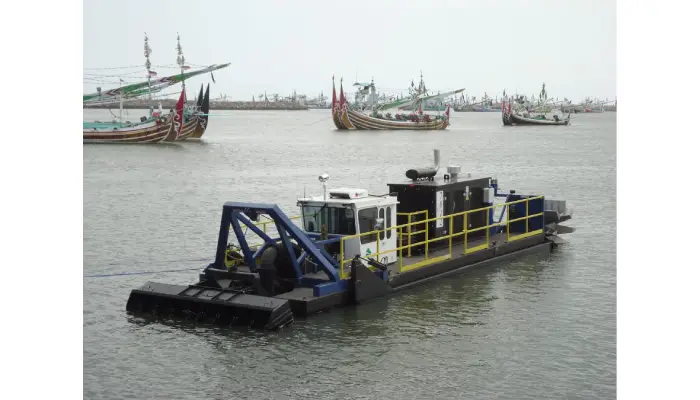
Essential Techniques for Effective Canal Dredging
Canal dredging is a vital process that involves removing sediment and debris from waterways to maintain depth and width, which is important for navigation and flood control. There are various techniques for dredging, including mechanical methods like clamshells for precise scooping, hydraulic methods using pumps for larger volumes, and cutter suction dredging for tougher materials. Proper planning involves surveying the area to understand sediment types and environmental impacts while ensuring compliance with regulations. Safety protocols are essential during operations, requiring training and proper equipment. After dredging, it’s crucial to monitor the site’s recovery and effectiveness while communicating with stakeholders.
1. Understanding Canal Dredging
Canal dredge is the process of removing sediment and debris from the bottom of waterways, which is essential for maintaining or increasing the depth and width of canals. This practice is vital for ensuring safe navigation, enhancing flood control measures, and supporting environmental restoration efforts. By regularly dredging canals, operators can prevent blockages that might impede boat traffic or lead to flooding.
Dredging can be particularly important in regions where sediment builds up quickly due to runoff or erosion. For example, in areas with heavy rainfall, sediment can accumulate rapidly, requiring timely dredging to maintain water flow. Additionally, dredging can be part of larger ecosystem management strategies, helping to restore habitats for fish and other aquatic life. Overall, understanding the basics of canal dredging is crucial for anyone involved in waterway management.
2. Mechanical Dredging Techniques
Mechanical dredging is a widely used method that employs specialized equipment to remove sediment and debris from the canal bed. This technique is particularly effective in shallow waters where precise excavation is crucial. Equipment like clamshells and backhoes are commonly used, allowing operators to scoop out material with accuracy. For instance, in a maintenance project for a small canal, a clamshell dredger can selectively remove accumulated silt without disturbing surrounding habitats. The process is not just about removing dirt; it’s about ensuring the canal remains navigable and safe for vessels. Mechanical dredging is also beneficial in urban areas where space is limited, as it minimizes the footprint of the operation. This method stands out for its versatility, adapting well to various sediment types and project requirements.
3. Hydraulic Dredging Overview
Hydraulic dredging is a widely used technique that employs suction pumps to efficiently remove sediment from the bottom of canals and transport it through pipelines. This method excels in deep channels where large volumes of material need to be extracted quickly and effectively. Unlike mechanical dredging, which relies on physical equipment to scoop out sediment, hydraulic dredging uses the power of water to create a slurry of sediments, making it easier to move the material over long distances without the need for extensive handling.
One significant advantage of hydraulic dredging is its ability to minimize disturbance to the surrounding environment. Since the suction process can be controlled more precisely, it reduces the likelihood of resuspending contaminants or damaging aquatic habitats. Additionally, the flexibility of hydraulic systems allows for continuous operation, which can lead to faster project completions and lower overall costs. For instance, in large-scale projects like maintaining navigational channels for shipping routes, hydraulic dredging provides a reliable solution that meets both efficiency and environmental standards.
4. Cutter Suction Dredging Explained
Cutter suction dredging is a highly effective method for removing sediment from waterways, especially when dealing with hard materials or mixed types of sediment. This technique uses a specialized dredger equipped with a rotating cutter head, which breaks up the sediment on the canal floor. Once the material is cut, it is sucked up through a pipeline using powerful hydraulic pumps. This combination of mechanical cutting and hydraulic suction allows for efficient dredging in various conditions, making it suitable for both deep and shallow waters.
One of the significant advantages of cutter suction dredgers is their ability to handle tougher sediments, such as clay or compacted soil. For instance, in areas where traditional dredging methods might struggle, like river mouths or harbors with mixed sediment types, cutter suction dredging excels. The dredging process is also more controlled, allowing operators to excavate specific depths and maintain the desired width of the canal. This precision is crucial for ensuring safe navigation and preventing sediment buildup that could disrupt water flow.
5. Essential Dredging Equipment
Dredging equipment plays a pivotal role in the success of canal dredging projects. Various types of dredgers, such as trailing suction hopper dredgers, cutter suction dredgers, and clamshell dredgers, are tailored for specific tasks. Trailing suction hopper dredgers are particularly useful for large-scale operations, as they can collect and transport sediment efficiently over long distances. In contrast, cutter suction dredgers are designed to handle tougher materials, making them ideal for areas with hard or mixed sediment.
Support vessels, including tugs and barges, are equally important as they help in transporting dredged material and equipment to and from the work site. These vessels provide the necessary logistical support, enabling a seamless operation.
Choosing the right equipment based on project needs is crucial. For example, in shallow waters where precision is key, mechanical dredging tools like clamshells or backhoes might be the best fit. On the other hand, when dealing with deeper channels or larger volumes, hydraulic dredging would be more effective. Proper equipment selection not only enhances efficiency but also minimizes environmental impact during the dredging process.
6. Planning and Design Process
The planning and design process is vital for successful canal dredging. It begins with detailed surveys to gather information about sediment types, depths, and potential environmental impacts. For instance, understanding the composition of the sediment helps in selecting the right dredging method. Once the survey is complete, a comprehensive dredging plan is developed. This plan includes the chosen methodologies, a timeline for operations, and the specifications for equipment needed.
Additionally, navigating through environmental regulations is essential. Dredging projects often require various permits, which necessitates thorough documentation and adherence to legal standards. This ensures that the project meets environmental protection guidelines while also fulfilling its functional goals.
7. Environmental Considerations in Dredging
Environmental considerations play a crucial role in canal dredging, as the process can significantly impact local ecosystems. Before any dredging begins, it is essential to assess the potential effects on aquatic life, including fish, plants, and other organisms that inhabit the canal. For example, dredging in spawning areas may disrupt fish reproduction, making it vital to time operations around breeding seasons.
Water quality is another important factor. Dredging can resuspend sediments and release pollutants trapped in the sediment, affecting water clarity and chemistry. Therefore, implementing sediment management strategies is necessary to minimize these impacts. This may involve monitoring water quality during dredging and using techniques to contain and manage sediment.
Moreover, dredged materials can sometimes be beneficially reused. For instance, clean dredged material can be used for habitat restoration projects, such as creating new wetlands or enhancing shorelines. This not only helps in managing waste but also contributes positively to the environment.
8. Safety Protocols for Dredging Operations
Safety is a critical aspect of dredging operations, ensuring the well-being of personnel and the integrity of the environment. Establishing clear safety guidelines is essential, covering everything from equipment operation to personnel conduct. Regular training and drills help prepare crew members for unexpected situations, such as equipment failure or adverse weather conditions. For instance, conducting emergency response drills can enhance readiness and reduce response times in crises.
Personal protective equipment (PPE) plays a vital role in safeguarding workers. This includes hard hats, life vests, gloves, and eye protection, all tailored to the specific hazards of dredging. Adherence to safety regulations, such as those set by the Occupational Safety and Health Administration (OSHA), ensures that operations meet industry standards and mitigate risks.
Communication is another key safety element. Maintaining open lines of communication among crew members and between vessels can prevent accidents. For example, using radios to report hazards or changes in conditions can keep everyone informed and safe.
9. Post-Dredging Monitoring Activities
After the dredging process, monitoring is essential to ensure that the site is recovering and to assess the effectiveness of the dredging operations. Regular inspections should be conducted to check for sedimentation and to see how quickly the ecosystem is bouncing back. For example, measuring water quality parameters and observing aquatic life can provide insights into whether the dredged area is reestablishing a healthy habitat. It’s also important to keep communication open with stakeholders, gathering their feedback on the dredging outcomes. This ongoing dialogue can help refine future projects and promote collaborative approaches to waterway management. Monitoring activities should also include evaluating whether the dredging met its intended goals, such as improving navigation or enhancing flood control. By actively engaging in these post-dredging activities, project managers can ensure that the benefits of dredging are realized and maintained over time.


